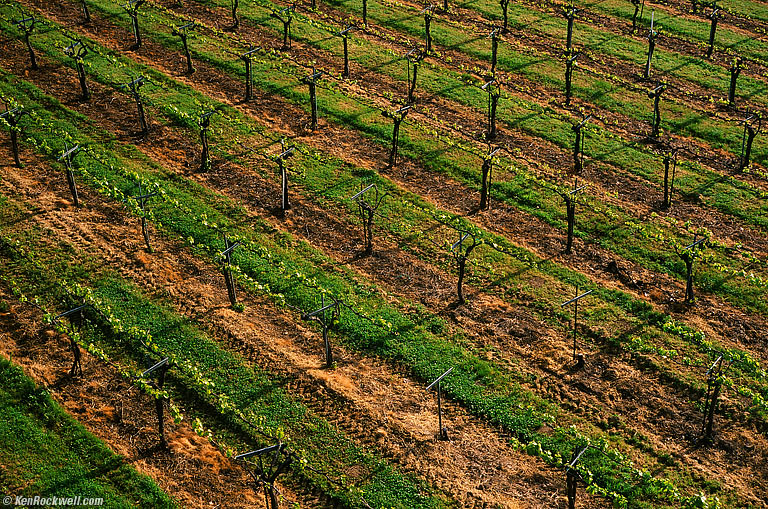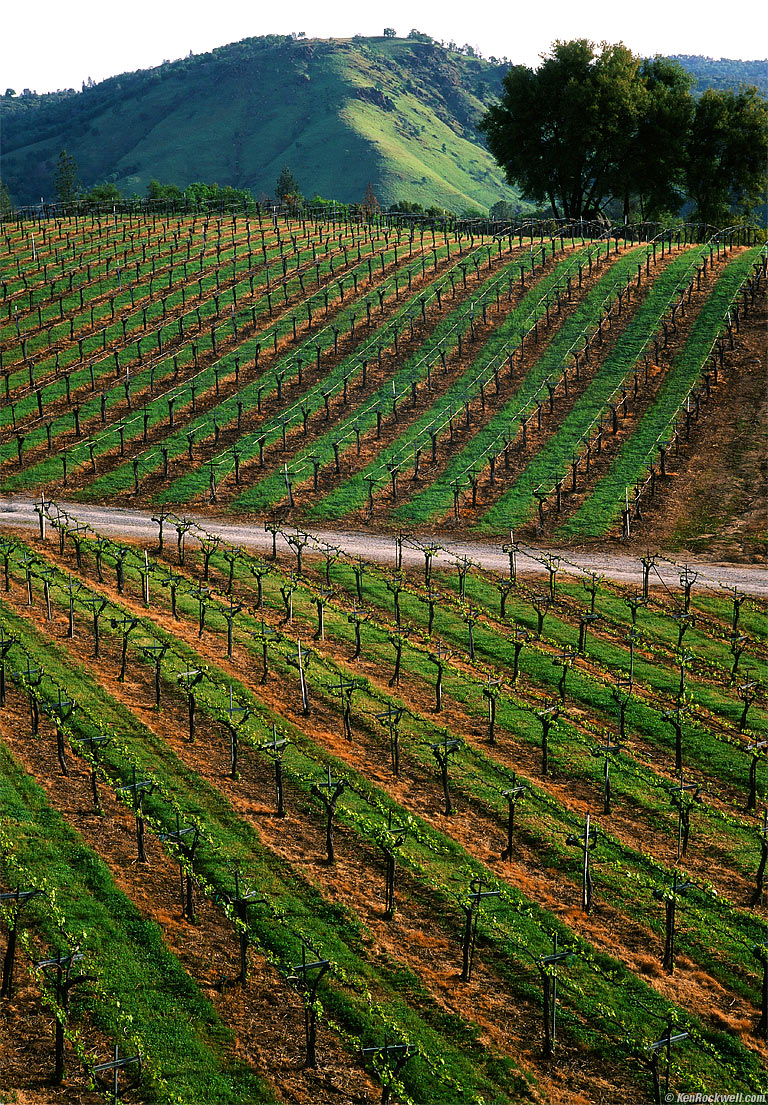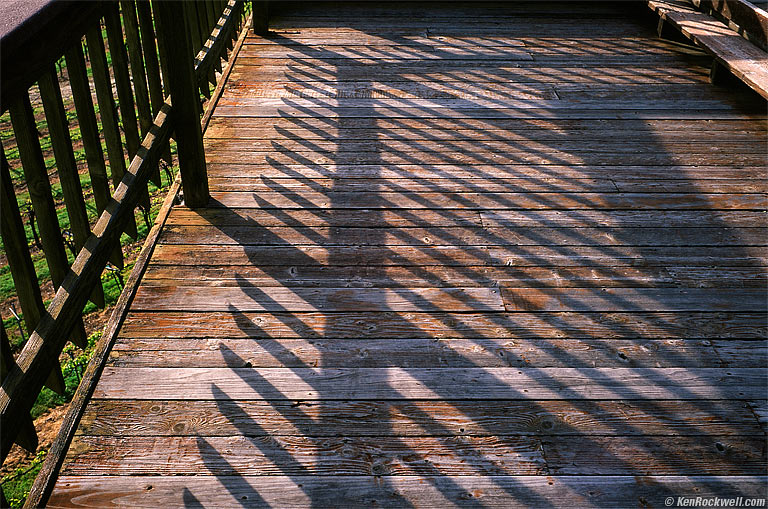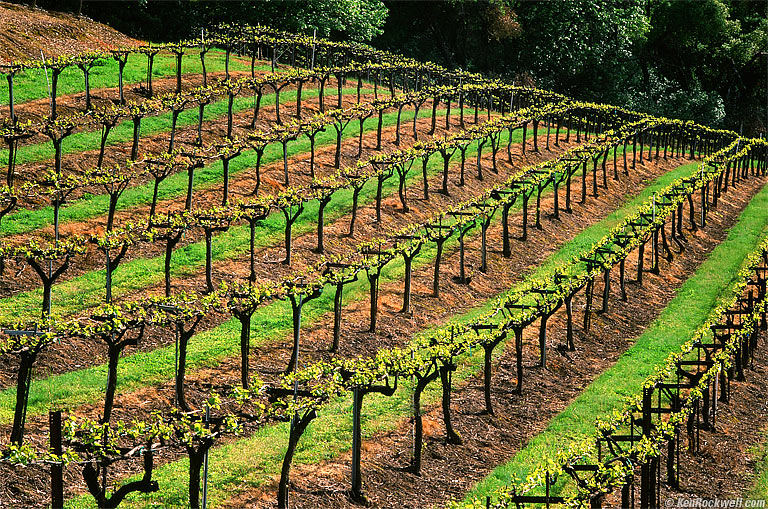Home Donate New Search Gallery How-To Books Links Workshops About Contact
California's Gold Country
17 April 2010, Saturday
16 17 18 19 20 21 April 2010 Tech Story
Today we arose in Sacramento, and made the short ride out to the extraordinary Gold Hill Vineyard in Placerville. Gold Hill is one of the very few wineries that also has its own brewery, good times!
There we were met by Ken, who welcomed us with breakfast, and off we went shooting.
Gold Hill Vineyard, Placerville, California.
This isn't a vineyard; it's a pattern of repeating lines and stakes.
This was shot on Fuji Velvia 50 with a LEICA MACRO-ELMAR-M 90mm f/4 with a B+W MRC 39mm 81A filter on a LEICA M6 TTL, from the winery's deck. NCPS process and scan.
Gold Hill Vineyard, Placerville, California.
This isn't about hills. It's about the contrast between two sets of parallel lines running in different directions and meeting in the middle.
This was also shot on Fuji Velvia 50 with a B+W MRC 39mm 81A filter on a LEICA M6 TTL. I most likely used LEICA MACRO-ELMAR-M 90mm f/4. NCPS process and scan.
Gold Hill Vineyard, Placerville, California.
This is a shot all about lines, pattern, rhythm and balance. I didn't think when I shot this, I just felt it, and balanced it in my finder. I knew from experience that you'd see the blue colors in the shadows, even though when I was there the shadows looked the same tan as the sunlit parts of the wood. Thus we have three colors, red, green, and blue, working together.
This was shot on Fuji Velvia 50 with a B+W MRC 39mm 81A filter on a LEICA M6 TTL. I used a LEICA SUMMICRON-M 50mm f/2, NCPS process and scan.
Gold Hill Vineyard, Placerville, California.
This was shot on Fuji Velvia 50 with a Hoya HMC 55mm 81A filter on a LEICA APO-SUMMICRON-M 90mm f/2 ASPH on a LEICA M6 TTL, NCPS process and scan.
This shot isn't a shot of a vineyard: it's a shot of green lines flowing off to the right.
I flipped the film so that the your eyes run from left to right. As shot, it was backwards, and American eyes wouldn't read it as smoothly.
Something I've done wrong is to show three of the same shots. The past three shots are nice, but they're the same thing: green bands. This gallery would be much stronger if I picked just one. That's the great thing about adding all these comments: when I see something that would take a little work to fix, it's easier just to write about it and call this an educational experience!
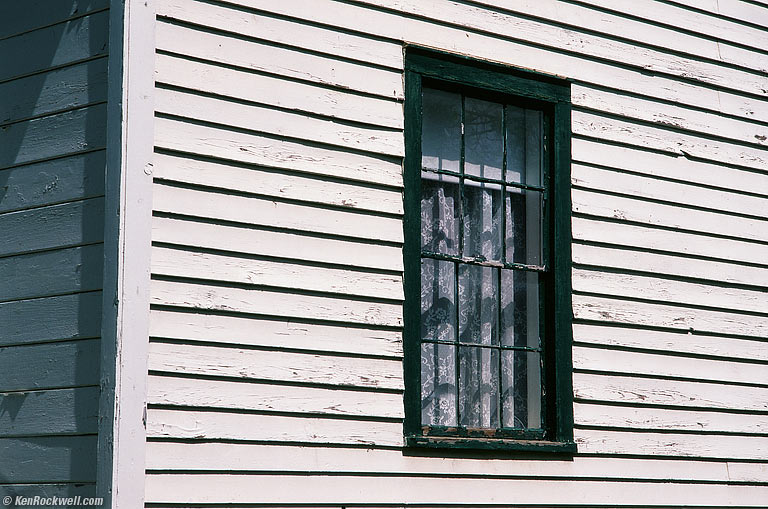
Coloma, California.
This isn't a shot of a window. It's a darker rectangle (played by the window) balancing against the larger gray rectangle on the left, played by the shadowed wall.
I'm too lazy to do it now that I've seen the image on this page, but it really needs to be straightened, then I need to crop-off the left eighth of the image so that the window is in balance with the darkness on the left.
This boring shot came from Fuji Velvia 50 with a LEICA MACRO-ELMAR-M 90mm f/4 on a LEICA M6 TTL, f/8 at 1/250. Since I wanted the white to look white, I shot with no filter. NCPS process and scan.
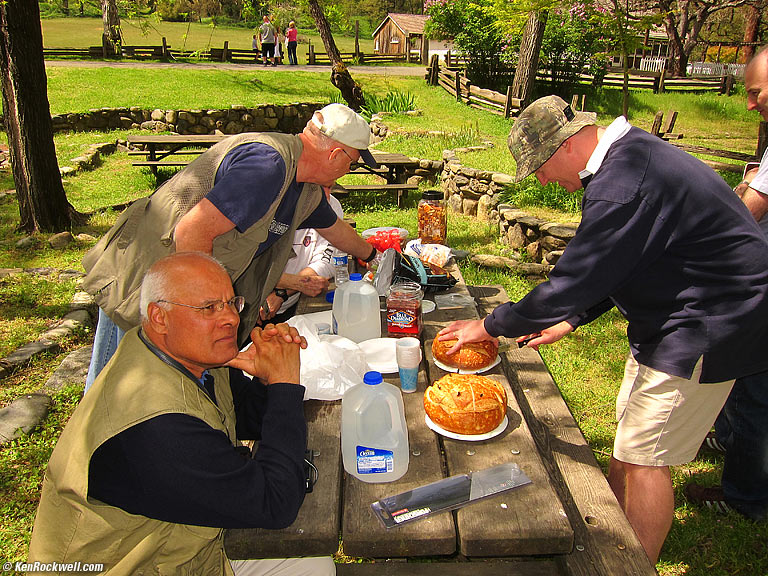
Picnic, Coloma, California.
Here we have gathered some of the world's greatest photographic minds, all at one table.
This was shot with a Canon S90, with it's flash on for fill. Since I'm shooting into the sun, I'd have lost everyone into dark blobs of shadows, except that the flash lit them.
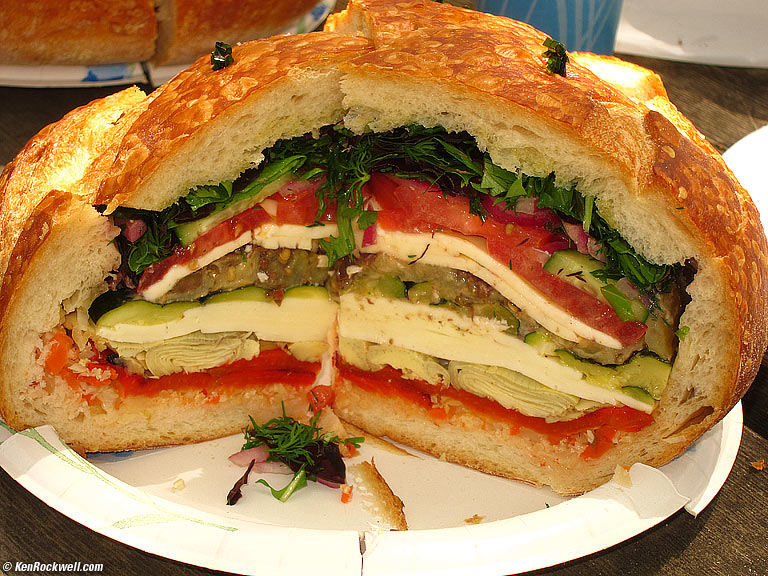
The Lovely Irene's Incredible Sandwich, as Served in Coloma, California.
And this is why these great minds gathered. These sandwiches are even better in our mouths than they look here.
This also was shot with a Canon S90, with it's flash on for fill for the same reason. Look at the direction of the sunlight: it's lighting the back of the sandwich, not the inside I'm showing here, which was lit by the flash.
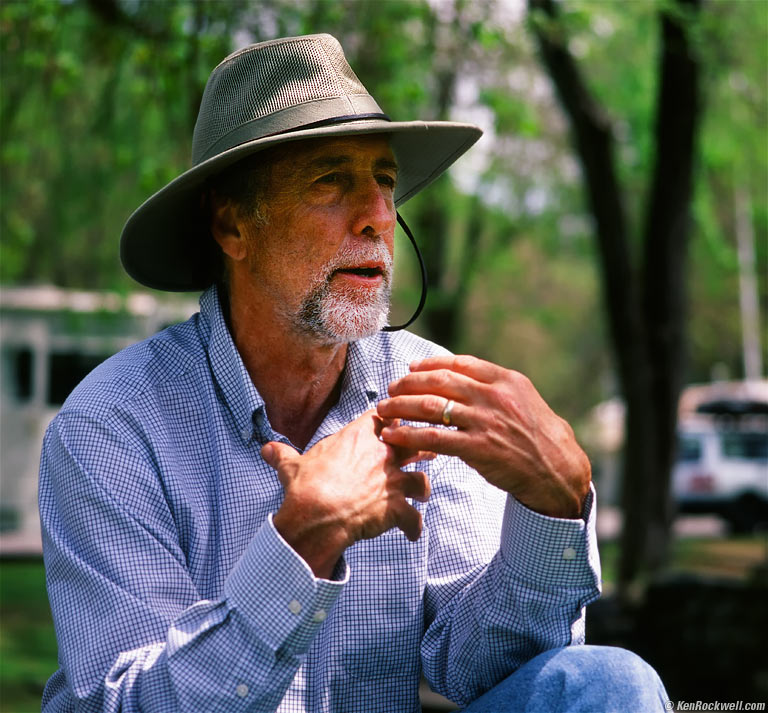
Dave Wyman Instructs after Lunch in Coloma, California, 12:29PM.
I dodged (lightened) Dave's face with a curves adjustment layer in Photoshop CS4, because otherwise his face was in deep, dark shadow under the brim of his hat. I also cropped off the garbage on the left and right; the 35mm frame is usually too wide and too short. By removing the sides, the image grows when constricted here to 768 pixels wide.
Once one makes a curves adjustment layer to lighten everything, one adds a layer mask, fills it with black, and paints white over it with a soft brush to lighten just Dave's face. This also lets me go back and change and edit everything about the dodging; Photoshop's primitive dodge and burn tools don't allow anywhere near the flexibility of adjustment layers and masks. Lightroom and Aperture try to allow these sorts of adjustments; I don't know how effective they are.
This is how it looked as scanned:

I should have burned (darkened) his hands, since they are so light in the sun that they distract us from his face, but I was too lazy.
The slide itself looks fine. The inexpensive scans I get at NCPS scans just can't capture all a slide has to offer (that costs $50 a slide for drum scans). Most scans make the shadows too dark. Also, computer screens can't match the brilliance of a light table (800 fL vs 300 fL) or the dynamic range (10,000:1 vs 100:1).
This shot came from Fuji Velvia 50 shot through a B+W MRC 39mm 81A filter on a LEICA MACRO-ELMAR-M 90mm f/4 on a LEICA M6 TTL, wide-open f/4 at 1/125. NCPS process and scan.
After lunch we met some of the local cowgirls and handed them our leftover lunch booty, as they drove their carriage around town. Next, we walked around Coloma.
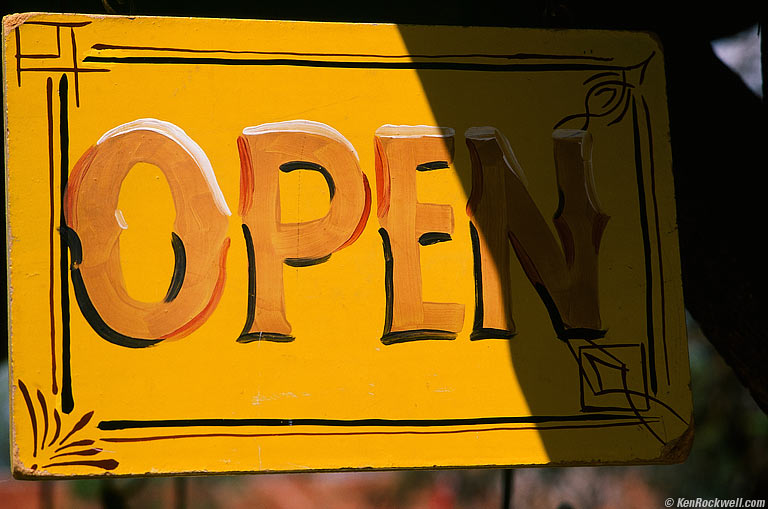
Open, Coloma, California.
Shot on Fuji Velvia 50 shot through a B+W MRC 39mm 81A filter on a LEICA MACRO-ELMAR-M 90mm f/4 on a LEICA M6 TTL, NCPS process and scan. I added 2/3 of a stop exposure as metered off the yellow to keep the yellow bright.
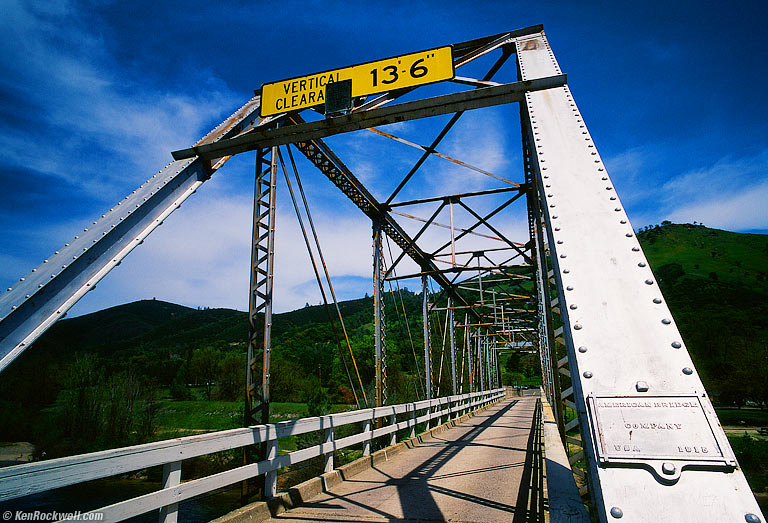
Bridge, Coloma, California.
I had a straight-on shot, but this one is better because I had the strong diagonal line take charge. I deliberately had it run down exactly to the lower right corner.
I suspect this image might be better flipped left-to-right, but I was too lazy.
Shot on Fuji Velvia 50 through a Hoya HMC 55mm 81A filter on a LEICA ELMARIT-M 21mm f/2.8 ASPH on a LEICA M6 TTL. NCPS process and scan.
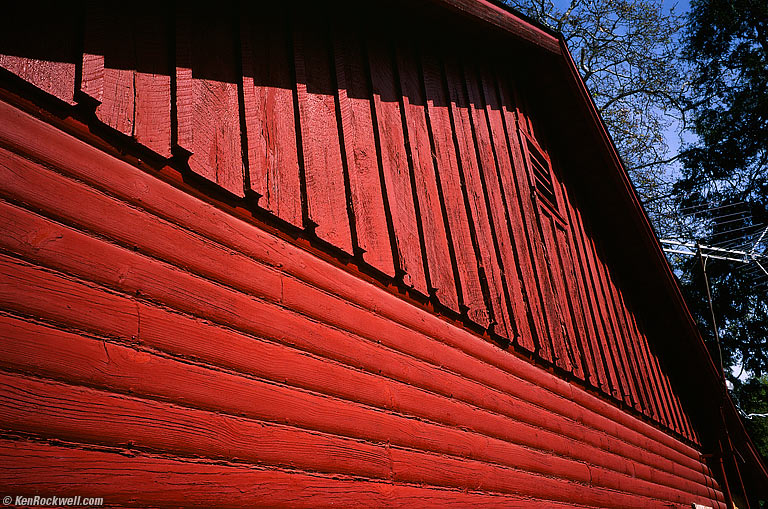
General Store, Rough and Ready, California.
We stopped at the general store in Rough and Ready.
This snap is all about lines, shapes and patterns. I want to grab your attention, and run it from left to right.
It could be as good in black-and-white, except that the red stands out and makes the wall appear to move closer to you.
I shot this on Fuji Velvia 50 through a Hoya Series VII 81A filter on a LEICA SUMMILUX 35mm f/1.4 on a LEICA M6 TTL, f/9.5 at 1/60, 10.5 feet focus. NCPS process and scan.

California Poppies, California.
This area, by the river, was wasted in earlier fires, so wildflower seeds were dropped all over, and years later, we have loads of springtime blooms.
This shot came from Fuji Velvia 50 shot through a B+W MRC 39mm 81A filter on a LEICA MACRO-ELMAR-M 90mm f/4 on a LEICA M6 TTL, about f/5.6 at 1/125. NCPS process and scan.
When shooting this close (closer than 1m with a 90mm lens without the macro adapter), the LEICA's finder tends to show a little more than one gets on film, so I just barely didn't lose the top of one flower. If I had shot this on any SLR, like a $20 Nikon EM with a Nikon Series E 100mm f/2.8, I would have gotten better results because I could have seen what I was doing.

Bridgeport Covered Bridge (built by Wood), California.
Northern California has more covered bridges than anywhere. They date from the 1800s, and were how civilized people crossed rivers.
This was shot with a Canon S90.
I didn't turn on the flash, since I wanted the natural light to show.
I set a manual white balance to give me much warmer (more orange) result than Auto would have given.
I had to be very careful to keep everything square. I tapped the DISP button to call up the grid on the LCD, which wasn't that helpful. I used Photoshop's Lens Distortion Correction tool to correct the rotation and horizontal and vertical perspectives to make it all square. While I was in that filter, I think I also put in something to correct the minor barrel distortion.
Auto ISO chose ISO 800, and f/2 at 1/20. I also dialed-in +2/3 compensation to lighten the entire image. If I hadn't, the S90 tried to expose for the light at the end of the tunnel, instead of the rafters. Image Stabilization kept everything sharp.
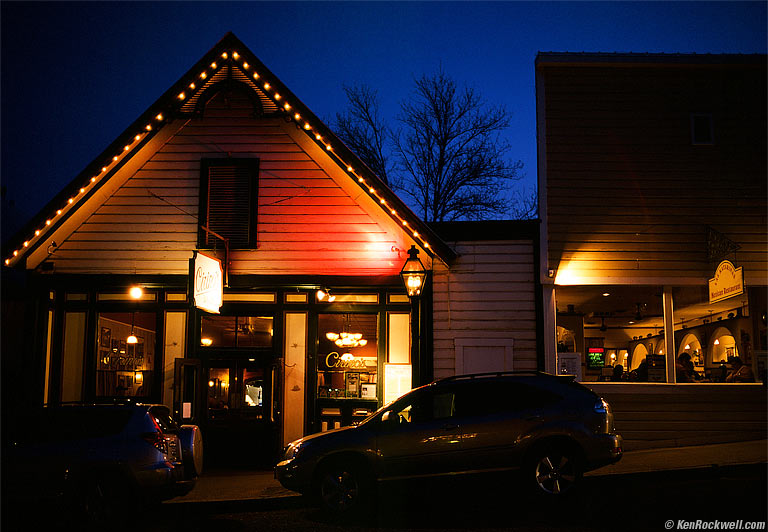
Nevada City, California.
We stayed in Grass Valley this night, and went out to dinner in Nevada City.
I rested my camera on a garbage can for the long exposure; I'm not taking a stinking tripod to dinner.
I shot this on Fuji Velvia 50 with a LEICA SUMMILUX-M 35mm f/1.4 ASPH on a LEICA M6 TTL, f/1.4 at 1/4. NCPS process and scan. I used no filter, since I wanted as much light as I could grab, and artificial light is already too warm.
A great thing about the LEICA SUMMILUX-M 35mm f/1.4 ASPH compared to any other fast 35mm lens, be it Nikon's newest 35mm f/1.4 AI-s or LEICA's own older LEICA SUMMILUX 35mm f/1.4, is that the LEICA SUMMILUX-M 35mm f/1.4 ASPH stays sharp in the corners at f/1.4, with no coma to turn the points of light into weird blobs. With the LEICA ASPH, dots of light remain as dots of light, so you can use f/1.4 without reservation.
16 17 18 19 20 21 April 2010 Tech Story
Home Donate New Search Gallery How-To Books Links Workshops About Contact
